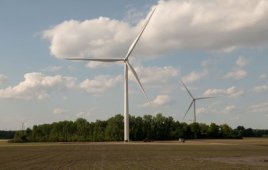
A technician anchors a Triton to the ground. The sodar unit can measure wind speed and direction at different elevations up to 200m.
Sodar or sonic detection and ranging, is a relatively recent tool for measuring wind speed and direction up to 200-m up. The task was usually relegated to meteorological tower that had to be built and often reached only 80-m up. Portable sodar units simplify the task. Recently, as part of continuing scientific research to understand wind resources, the National Renewable Energy Laboratory (NREL) and sodar developer Second Wind Inc, Somerville, Mass., partnered to characterize the performance of Second Wind’s Triton Sonic Wind Profiler.
The following is an edited version of conclusions reached by NREL authors. Their analysis (http://tinyurl.com/wpenrel) of the wind resource data provided by Second Wind Inc., came from 10-min data samples over a 198-day period. It was collected from an 80-m meteorological tower and a Triton sodar system from a measurement program conducted near an operating wind farm in western Texas. NREL did not participate in the measurement phase of the study. The tower configuration, specs of the locations of the met tower and sodar unit, and the data collection were done by the wind-farm developer with assistance from Second Wind. The collected data were then sent to NREL for analysis.
“Our analysis of the sample Triton data set shows excellent agreement with the tower measurements,” says the NREL report. “Given the 200 m distance between the sodar and the met tower, it would be unreasonable to expect a perfect correlation between the two datasets.” From the data provided, NREL engineers make these observations:
• The operational uptime was greater than 98%, demonstrating sodar’s operational reliability during this 198-day period.
• Triton’s (sodar) measured wind speeds correlated well to the meteorological tower, but were generally slightly lower. The correlation coefficients were greater than 0.983 at both heights (50m and 80m).
• The Triton’s measured wind direction also correlated well to the tower data when the sector containing the wind farm was removed. At 80 m, the correlation coefficient calculated between the Triton and the wind vane was 0.994.
• The wind direction distributions as measured by the Triton and the tower were consistent. A slight rotation of the directions may be attributable to instrument alignment, or may reflect an actual difference in the wind direction over the horizontal distance of 200 m between the meteorological tower and the Triton.
• The percent of valid data (Q >= 90%) measured by the Triton was greater than 95% at 80m and was approximately 81% at 120m.
• Shear exponents calculated from the tower and Triton data were comparable in terms of overall shear as well as daytime and nighttime shear.
• A discrepancy in the average turbulence intensity was measured by the two instruments. At 80m, the Triton measured an average TI of 0.100, while the average 80m TI on the meteorological tower was 0.132.
Filed Under: Uncategorized





